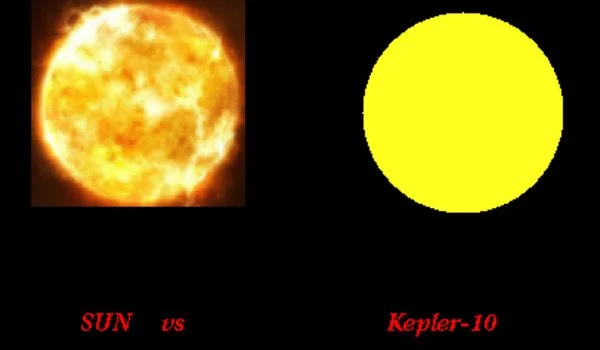Kepler-10 is a Sun-like star located 187 parsecs (608 light-years) from Earth in the constellation Draco. It is located about 608.3 light-years (186.5 pc) away from our solar system. Kepler-10 was chosen by NASA’s Kepler spacecraft because it was the first star identified by the Kepler mission as potentially hosting a small, transiting exoplanet.
Kepler-10 is slightly less massive, slightly larger, and slightly cooler than the Sun; at 10.4 billion years old, it is nearly 2.6 times the age of the Sun. The star has an apparent magnitude of 11.2, with absolute magnitude of 4.8. Kepler-10 is home to at least two planets in a planetary system. It is 0.9 times more massive and 1.1 times bigger compared with our Sun. After eight months of observation, Kepler-10b, the first undeniably rocky planet, was discovered in its orbit and announced on January 10, 2011.
The planet orbits its star closely, completing an orbit every 0.8 days, and has a density similar to that of iron. The second planet, Kepler-10c, was confirmed on May 23, 2011, based on follow-up observations by the Spitzer Space Telescope. According to the data, it has an orbital period of 42.3 days, a radius more than double that of Earth, but a higher density, making it the largest and most massive rocky planet discovered as of June 2014.

Nomenclature and history
Kepler-10 was named after the tenth planetary system observed by the Kepler spacecraft, a NASA satellite designed to search for Earth-like planets that transit, or cross in front of, their host stars with respect to Earth. The transit dims the host star slightly, and Kepler notices this periodic dimming effect. After eight months of observations, from May 2009 to January 2010, the Kepler team named Kepler-10b the first rocky exoplanet discovered by the Kepler satellite.
Kepler-10 was the first Kepler-targeted star suspected of harboring a small planet. As a result, the W.M. Keck Observatory in Hawaii prioritized verifying Kepler’s discovery. The discovery was successfully validated. Although there had been many potentially rocky exoplanets discovered in the past, Kepler-10b was the first definitively rocky planet to have been discovered.
The discovery of Kepler-10b was announced to the public at a winter meeting of the American Astronomical Society on January 10, 2011 in Seattle. On May 23, 2011, the existence of Kepler-10c was confirmed at the 218th AAS meeting in Boston.
Characteristics
Kepler-10 is a G-type star, like the Sun. With a mass of 0.895 (± 0.06) Msun and a radius of 1.056 (± 0.021) Rsun, the star is approximately 10% less massive than and 5% wider than the Sun. The metallicity of Kepler-10, as measured in [Fe/H] (the amount of iron in the star), is -0.15 (± 0.04); this means that Kepler-10 is about 70% as metal-rich as the Sun.
Metallicity tends to play a large role in planet formation, determining whether or not a planet will form and what type of planet will form. Furthermore, Kepler-10 is estimated to be 11.9 billion years old, with an effective temperature of 5627 (±44) K; by comparison, the Sun is younger and hotter, with an age of 4.6 billion years and an effective temperature of 5778 K.
Kepler-10 is 173 (±27) parsecs away from Earth, which equates to 564 light-years. Furthermore, Kepler-10’s apparent magnitude (or brightness as seen from Earth) is 10.96, making it invisible to the naked eye.
Planetary system
According to standard exoplanet naming conventions, the first planet discovered orbiting Kepler-10 is known as Kepler-10b. It was announced in 2011 as the first rocky planet discovered outside of our Solar System. The planet has a mass 3.33±0.49 times that of Earth and a radius 1.47+0.03-0.02 times that of Earth. The planet orbits Kepler-10 at a distance of 0.01684 AU every 0.8375 days, which is comparable to Mercury’s orbit and orbital period, which circles the Sun at a distance of 0.3871 AU every 87.97 days. The planet’s eccentricity is nearly zero because it orbits so close to its star. As a result, it has an extremely circular orbit.
















